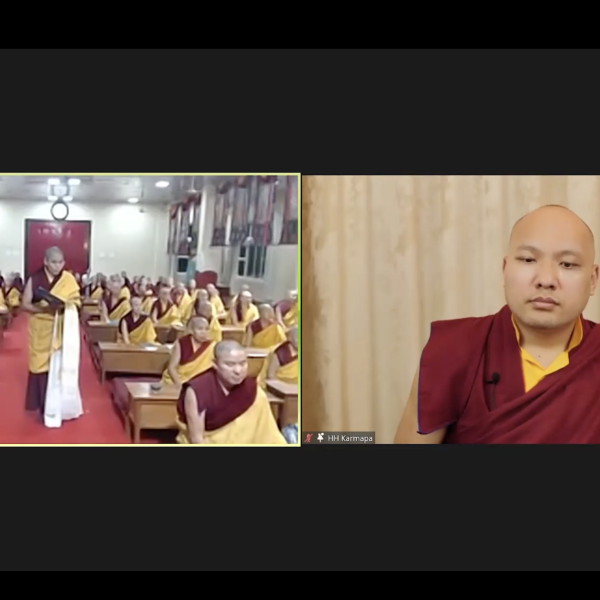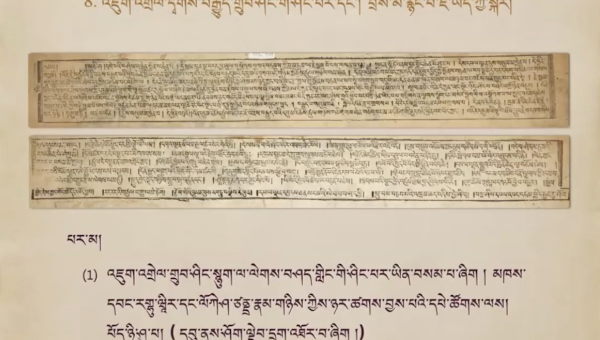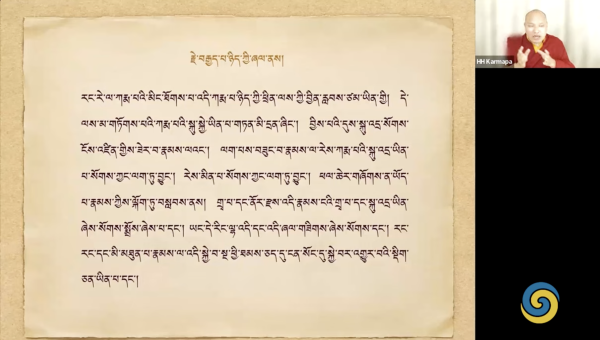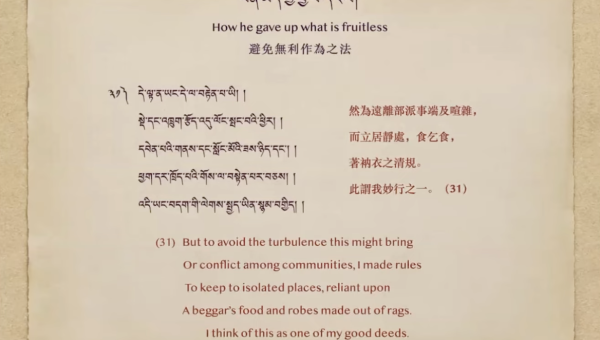Spring Teaching 2023 • Two Autobiographical Praises by Mikyö Dorje • Day 13 Part Two
16 May 2023
Of all the Karmapas, the collected works of Mikyö Dorje are the most extensive that remain. Though Karma Pakshi was said to have written as many volumes as there are in the Kangyur, which has more than one hundred (some editions have 103, others 110), by the time of Pawo Tsuglak Trengwa (1504–1566 CE), only sixteen volumes remained. In contrast, the Feast of Scholars credits Mikyö Dorje with over thirty volumes, of which 90% are preserved in his Collected Works.
Mikyö Dorje's writing has impressive qualities. The Drepung manuscript of the commentary on the Autobiographical Verses: Good Deeds describes his output:
In terms of their composition, at the age of 22, he wrote a textual commentary on the Vinaya Sutras. At 23, he wrote the great commentary on the Prajnaparamita. ; at 24, a great commentary on the Kalapa Grammar; at 26, an extensive commentary on the Vinaya Sutras;and at 27, his great commentary on the Treasury of Abhidharma. He also wrote countless other texts of his own or commentaries on others' works, such as the Guhyagarbha Commentary on the meaning of unexcelled Vajrayana tantra.
The Karmapa explained that all these works were original compositions, not plagiarisms or based on the work of other scholars but generated by his own intelligence and understanding. The longer other scholars examined these texts, the more profound their meaning became. If we compare them with the work of other lamas, the latter are often basically texts to be recited, smoke offerings, torma offerings and other ritual practices. In contrast, Mikyö Dorje's texts contain explanations of both sutra and tantra, commentaries, notes on the historical background, pith instructions, texts on the various sciences, and notes on the historical background. The topics they explore are vast, and his vocabulary is complex. These texts, especially the commentaries on the Middle Way, Prajnaparamita, Vinaya and Abhidharma, are among the most well-known and highly respected texts not just in the Karma Kamtsang but in other Tibetan schools as well. Mikyö Dorje's commentaries on philosophical texts are very long and detailed; they include all the meanings of the words, an explanation of the meanings of different presentations, rebuttals, refutations, and so forth.
Though Dusum Khyenpa founded the Karma Kagyu, Mikyö Dorje's works are at the heart of study and practice. The Karmapa pointed out that the Karma Kamtsang recite the aspiration:
May I achieve in all my lives
A state that's never separate
From the guru, Mikyö Dorje.
They do not say "separate from Dusum Khyenpa".
These days Mikyö Dorje is not just important for philosophical studies and the texts studied in the shedras but also for daily practice. He composed the "Four Session Guru Yoga", the Chakrasamvara Mandala Puja, the torma offering to Mahakala known as the MagDaMa, the aspiration "By these, my roots of virtue…" and other texts used in monastic rituals and practices.
He had a critical role in preserving the Seventh Karmapa's text on Validity and Epistemology. It was almost lost, but Mikyö Dorje gathered the fragments together and completed the text.
He was the Tsongkhapa of the Karma Kamtsang. Through his compassionate and bodhichitta activity, the Kamtsang and the teachings will survive two-thirds longer than otherwise, as predicted by Karmapa Deshin Shekpa.
"When we consider Lord Mikyö Dorje's actions of body, speech and mind, we can say that they were all solely for the sake of sentient beings. He was engaging in benefitting beings," the Karmapa commented and then quoted from the Dhammapada:
Buddhas do not wash away misdeeds with water,
Nor do they remove the sufferings of beings with their hands,
Neither do they transfer their own realisation to others.
Teaching the truth of suchness, they liberate (beings).
The only way to teach the path to liberation is to develop your own experience and realisation, to practise and manifest it yourself. In this way, you can benefit beings and bring others to higher states. This is why the deeds of speech are seen as supreme and the most powerful among those of body, speech and mind.
To repay the great kindness of Mikyö Dorje and become his authentic followers, we need to work collaboratively to collect together and preserve his works and these namthar, the Karmapa advised. They need to be compiled, published, researched by scholars, and used in listening, contemplation and meditation. They are essential and to be cherished: "This is the best method for us to uphold, preserve, and spread the teachings. I think this is even better than founding 100 monasteries because if you build 100 monasteries and temples, in the end, all you have are empty buildings. And what's the point in that?"
A Background to Mikyö Dorje's Works
The Karmapa then focused on specific texts composed by Mikyö Dorje, the commentaries on the Middle Way, Prajnaparamita, Vinaya and Abhidharma. He explained that in the Tibetan scholastic tradition, there were the Four Difficult Texts or Topics, but it's not completely clear which they were. Sometimes it seems to mean these four— the Middle Way, Prajnaparamita, Vinaya and Abhidharma — which, combined with Validity, make the Five Great Texts [studied in shedras]. Sometimes it appears that the Four Difficult Texts were Validity, Prajnaparamita, Abhidharma, and Vinaya, without the Middle Way. In the olden days, scholars who had mastered these four texts were known as Ka-Shiwa.
The Karmapa said he would speak in terms of three topics: how Mikyö Dorje wrote the commentaries; the printed and handwritten editions of these texts; and the importance of compiling a well-edited, critical edition of the texts.
The composition of the texts
The Commentary on Entering the Middle Way:
In the Wood Dragon Year (1544), Mikyö Dorje began to write Chariot of the Practice Siddhas. In the Wood Snake Year (1545), when he was invited to Mön, he completed the text at Domtsang Rong. Karma Dana Yandapak requested it
The Commentary on the Ornament of Clear Realization [Prajnaparamita]:
In the Earth Ox Year (1529), at the age of 23, he began The Noble Ones Resting at Ease: A Commentary on the Ornament of Clear Realization and completed it in the summer of the Iron Hare Year (1531), at the age of 25, at a park outside the temple of Jamyang Gyepay Dangden. Over 150 bhikshus were observing the rains retreat there, and he completed the commentary on the first day of the waxing phase (the 16th day of the Tibetan month). As the colophon of The Noble Ones Resting at Ease says: The basis for the current Palpung edition was an edition supported by Depa Samde and the woodblocks carved at Gatsal Shungluk Ling, as the colophon states.
The Vinaya Commentary:
In 1527, when he was 20 years old, he wrote an explication of the text of the Vinaya Sutras. In the Earth Rat Year (1528), at 22, he wrote An Explication of the Text of the Vinaya Sutras, as both Pawo Rinpoche's history and Sangye Paldrup's commentaries say. In the Water Dragon Year (1532), at 26, he completed writing the Orb of the Sun: A Great Tika on the Vinaya Sutras. We know it was the Dragon Year because the colophon states, "I began at the age of 26 and completed when I was 27." He gave it this name because of a dream he had that the sun was filling the entire world.
The Commentary on the Abhidharma:
He began writing The Springtime Cow: A Commentary on the Treasury of Abhidharma in 1532 when he was 26. He wrote the first two chapters while travelling from Kongpo to Ü. In the Earth Pig Year (1539), he completed Chapter Three while staying at Nyuk Gyalkhang for the winter. In the Iron Ox Year (1541), he finished the 4th and 5th chapters. Finally, he completed the entire commentary in 1543. This is clear from the colophon. The composition of this commentary is also clearly described in a text called History of the Great Karmapa's Commentary on the Treasury of Abhidharma.
Extant Editions and Manuscripts
His Holiness explained that there are several editions of these extant texts; some were published by Karma Lekshey Ling, some by Vajra Vidya, one by the Jamgon Kongtrul labrang, and an edition published by Nitharta.
Chariot of the Practice Siddhas
- There is a woodblock edition said to be from Nyukla Lekshe Ling. It is in the 20th volume of manuscripts preserved by Raghuvira and Lokesh Chandra. However, the first six folios are missing.
- The Palpung woodblock. This is the basis for all modern editions in book format. It was originally prepared during the lifetime of Situ Pema Wangchuk Gyalpo, and there is a publisher's colophon by Jamyang Chökyi Gyaltsen. It is the most widespread edition.
- There's a manuscript preserved in the Cultural Palace of Nationalities in Beijing.
- In 1969, Topga sponsored the publication in Delhi of a facsimile of a manuscript edition, said to be based on a handwritten manuscript. This needs to be researched thoroughly because it is not copied from the Palpung woodblock but comes from a different source. The Karmapa believes that this may be one of the manuscripts that the 16th Gyalwang Karmapa was able to bring with him when he escaped from Tibet.
The Noble Ones At Ease
- There is a woodblock edition from Gatsal Karma Shungluk Ling. It was sponsored by Samde, a descendent of the Tibetan kings. The Karmapa believes that this may be the edition published at the time of Mikyö Dorje himself. It is five volumes among the old texts preserved at Jyeku Shanggu Monastery by Ato Tulku. Some of the original folios are missing from the middle of the text; they have been filled in from newer editions.
- Then there is the Palpung woodblock edition. Prepared during the life of Situ Pema Wangchuk, it is the basis for all the present editions in book format; it is the most widespread.
- There is only one manuscript extant; it is rather beautiful and in colour.
The Orb of the Sun: Commentary on the Vinaya Sutras
- There is a woodblock edition from Gatsal Karma Shungluk Ling.
- There is a Palpung woodblock edition.
- There is a manuscript preserved in Tibet at DrepungNechung Lhakhang.
- There is also a manuscriptfrom the Beijing Cultural Palace of Nationalities, at Drepung monastery.
The Springtime Cow: A Commentary on the Treasury of Abhidharma
- The Palpung woodblock edition is the only printed edition. They say they based it on two manuscripts, one from Palpung and one from Tsurphu.
- There is a manuscript from the collected works of Mikyo Dorje at the Potala Palace in Lhasa.
- A manuscript is also preserved at the Cultural Palace of Nationalities.
The importance of producing well-edited critical editions of these texts
The Karmapa said he believed there might be more woodblock editions and manuscripts not yet discovered, so it was important to search for and collate them.
It was also imperative to produce well-edited, critical editions of these texts, which consider the differences and anomalies between the extant versions of the texts and try to establish an authentic text.
At the time of the 11th Kenting Tai Situpa Pema Wangchuk, Jamyang Chökyi Gyaltsen was responsible for editing the woodblock editions of Mikyö Dorje's commentaries on the great philosophical texts. He composed publisher's colophons and wrote this at the end of the Abhidharma commentary The Springtime Cow:
When preparing this edition of the Eighth Karmapa Mikyö Dorje's commentary on the Treasury of Abhidharma, we found no other edition like this one. There was a handwritten manuscript at Palpung itself and another manuscript in the texts at Tsurphu, which we borrowed. But in all respects—their general meaning, words, meaning, and so forth, the differences between these two are great; little was the same. In particular, the first four chapters and especially the first two were not at all similar. Though I do not know which is better, in recognising the omissions, additions, and particulars, I became somewhat skilled, and as the basis for this edition, we used the Tsurphu manuscript.
Generally, however, Mikyö Dorje wrote the text—first spontaneously and then later editing them and so forth—when there are several manuscripts, they are never the same. With the commentaries on the Vinaya Sutra, Prajnaparamita, and the Middle Way, the manuscripts and printed editions are not at all the same, but the basis for the edition must be one in which all can have confidence.
In particular, the printed editions and manuscripts of the Middle Way commentary are in their composition and style individual; the differences are great. This manuscript is an initial draft where he spontaneously wrote what he thought without changing it, and is incredible and amazing. Thus it must not be considered unimportant; it is something that researchers should know.
Further, the Karmapa cited the Autobiographical Verses: Good Deeds as an example of anomalies between editions. There are two different extant manuscripts, one from the Potala and one from Drepung. However, there is a difference of five to six folios between them. Not just that, the root verses differ too. Thus, of these two manuscripts, the Drepung manuscript seems like the initial draft, and the Potala manuscript is possibly a later manuscript that had been edited. Things which were unclear in the former are clearer in the latter. Both are crucial, so he has decided both should be included in the Collected Works that he is currently collating. There are similar significant differences in the commentaries on the great philosophical texts.
The way forward, the Karmapa suggested, is a collaborative effort amongst the shedras, similar to the way in which the Kagyu Guncho is planned. The old printed editions and manuscripts need to be compared and critical editions produced for publication. Research and editing have to be done to the standards of international scholarship. The result should be authoritative editions of the texts accepted by all the shedras.
Historically, various upheavals and destruction struck the Kagyu. Consequently, most of the works of the previous Karmapas have been lost, and it is a great fortune that most of Mikyo Dorje's work still exists. It is a jewel that needs to be restored.
The conclusion of the teaching on The Praise: He searched thoroughly
Gyalwang Karmapa now turned to verses eight and nine of The Praise: He searched thoroughly. According to the Fifth Shamar's annotated commentary, the eighth stanza teaches how Mikyö Dorje dedicated his own and others' virtue:
He wished with love to exchange himself for those thought to be great
And created connections with them through pure aspirations,
Making dedications to rouse their intelligence
For engaging in virtue—to him, I pray.
According to the Fifth Shamar, Mikyö Dorje wished with heartfelt love to exchange his own self for others thought to be great in the world, such as Brahma. Through his pure aspirations, he was able to make connections with them, dedicating his own and others' virtue as a cause for perfect enlightenment.
Pawo Tsuglak Trengwa's commentary in the Feast for Scholars says that the eighth stanza teaches an example of Mikyö Dorje's activity of liberating peace and existence forever. "Those thought to be great" refers to those who are not actually great such as the chakravartin (universal emperor), of whom Brahma is one. Though they are considered great and powerful, they are still within samsara, temporarily enjoying a pleasant result. Ultimately, because they lack the indestructible nature, they will fall from high to low because they have not transcended the nature of compounded existence, which is of the nature of suffering. Not only that, the arhats, pratyekabuddhas, and bodhisattvas up to the 10th bumi have not yet reached the ultimate stronghold. They are like travellers who still remain on the path. They haven't reached their actual destination or fulfilled their final intention. Because of this, they also deserve our compassion, and that's the reason Mikyö Dorje engages in tonglen (exchanging self and others) with them. Impelled by the power of non-referential, loving compassion, he was able to arouse in them the distinctive intelligence of wisdom and the resolve of relative bodhichitta. In order to do this, he dedicated all his own virtue - past, present, and future - and all the virtue accumulated throughout the three times, for this purpose. In brief, just as long as space remained, as long as there were sentient beings, he would perform activity that is inseparable from the activity of all the beings.
On to the ninth verse:
By the virtue thus gained by stating his qualities,
May expressing the qualities of him who has qualities
Lead to a meaningful body and mind, perfected and purified,
And fulfil the intentions of the Karmapa.
According to the Fifth Shamar's commentary, this stanza teaches how reciting this prayer fervently and for a long time fulfils the aspirations of the master himself.
According to Pawo Tsuglak Trengwa, the ninth stanza is the "inconceivable dedication and conclusion". Mikyö Dorje wrote this as a list of his own qualities without any exaggeration or denial. By stating these qualities, in the future, others would be able to understand what he was speaking about, because of understanding that they would develop faith, and because of that, they would follow his example, or at the very least, they would recite it. Any virtue, directly or indirectly accumulated, must be dedicated, so this verse is the dedication by Mikyö Dorje.
But how, questioned the Karmapa, do you gain merit or virtue from stating your own qualities? In one sutra describing his birth and life, the Buddha teaches his own deeds. By teaching his own deeds, he brings many students into ripening and liberation, thus creating virtue.
The dedication is for Mikyö Dorje's own speech to be pure and clear. It seems he had a speech impediment. Something was wrong with his tongue, and he could not pronounce his words clearly. This is evidenced by a praise of Avalokiteshvara he wrote in which he laments the problem with his tongue and lack of clear pronunciation. Ultimately, the dedication is for him to have a meaningful body in order to awaken to buddhahood and bring all beings to that state, fulfilling the intentions of the Karmapa, who is inseparable from Buddha Amoghasiddhi, the embodiment of the activity of all buddhas.
In brief, Pawo Tsuglak Trengwa explains the Praise as a dharma teaching through Mikyö Dorje's namthar or spiritual biography, and summarises each stanza as follows:
The 1st stanza states Mikyö Dorje was not satisfied merely by being given the title of Karmapa and instead sought the actual teachings, receiving the teachings in full.
The 2nd stanza teaches that he knew how to properly distinguish dharma from non-dharma, and gave up natural and disobedient unwholesome actions.
The 3rd stanza teaches how he followed his teachers as dearly as his own life.
The 4th stanza advises understanding that everything is futile and learning to be content.
The 5th stanza advises training in bodhichitta, the essence of the Mahayana.
The 6th stanza advises only to consider the state of one's own continuum and tame one's own mind stream.
The 7th stanza advises that, instead of being satisfied with nonsense and following what others say, gain realisation through an impartial mind and through your own prajna.
The 8th stanza teaches that nothing is worth aspiring for except perfect enlightenment, so achieve that and seek lasting liberation for everyone in peace and existence.
The 9th stanza is advice to dedicate all virtues to great enlightenment.
Fifth Shamar Könchok Yenlak's commentary says that
This supplication, known in the Land of Snows as "He Searched Thoroughly…" that I have thus annotated, was offered as a praise by the Gyalwang to his great tutor Karma Trinleypa, when he was staying at Namtö Mountain. The tutor said, "I do not have such qualities as these, so I offer this praise to you, my lord," and offered it back to him.
The Karmapa explained that this was very similar to the praise by Je Tsongkhapa known as the Migtsema,which Tsongkhapa offered as a supplication to his own tutor, Geshe Redawa:
Lord who knows the stainless, Manjushri,
Great trove of limitless compassion Avalokiteshvara,
Crown Jewel of Tibetan scholars Redawa,
Shönnu Lodrö: I bow to your lotus feet.
Protect me, this bee who seeks liberation.
Geshe Redawa returned it to Tsongkhapa, saying, "It is not appropriate to praise me like this. It is worthy of the Dharma Lord Lobsang Drakpa himself," and changed it into a praise of Tsongkhapa.
In conclusion, the Karmapa said that among all the different praises used within the Karma Kamtsang, this one of Mikyo Dorje's is probably the most well-known, and drew this year's teachings on the Autobiographical Verses: Good Deeds and The Praise: He searched thoroughly to a close. He explained that there was more to be said, but he was waiting to get a couple of important manuscripts. Once he received them, he would continue the topic.





















